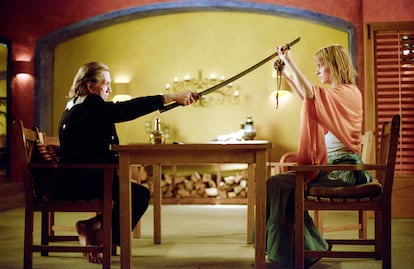How Quentin Tarantino created a feminist heroine in ‘Kill Bill,’ who later turned against him
Several film critics analyze the influence of Beatrix Kiddo, a character who is equal parts tender and violent. Uma Thurman and the director’s relationship went awry, following a troubled shoot in the shadow of Harvey Weinstein

“Pai Mei taught you the five-point exploding heart technique?” Bill asks, understanding that the woman he calls his favorite person — which didn’t stop him from repeatedly trying to murder her — has just killed him. “Of course he did,” she replies through tears. And that is how Beatrix Kiddo (Uma Thurman) ends the Kill Bill saga (directed by Quentin Tarantino), the title of which comes from Beatrix’s desire to kill the man who took away her chance to be happy. The well-known sequel turns 20 years old this April, but the Black Mamba — also known as The Bride — continues to generate a lot of interest today: “Kill Bill enriched the entertainment landscape of its time as well as that of today. It has become an icon, and icons never get old,” says María Castejón Leorza, a film critic and author of the book Rebeldes y peligrosas de cine (Cinema’s Rebels and Dangerous Women).
We all remember how the story begins: a group of assassins, including Bill, the protagonist’s ex-partner, tries to kill her on her wedding day, an event that, for her, represents a rebirth and a move away from bloodshed and crime. After a time in a coma, the martial arts expert awakens, using revenge as a motive to continue living. In the second installment, although she has already managed to eliminate two of her main enemies, she still has to finish off three others, including Bill, whose orders they follow.

Judging by both her past actions and her future motivations, one could say that Beatrix Kiddo is herself a lethal weapon, but she is also much more than that: the Black Mamba can be tender, but she’s also capable of enduring a severe master’s tortures to become an unbeatable fighter; she would never kill a mother in front of her daughter, but she does not hesitate to plunge her katana into her enemy’s body when the little one is not there. She is full of contradictions and has a series of attributes that make her different from any character that had been seen before in cinema, and she became a favorite of many moviegoers. “Beatrix’s character has many qualities to like: as a good heroine she has a very clear objective and nothing gets in her way no matter how much she suffers; thus, she has the classic components of a fictional hero. However, she is played with a lot of nuances in her emotions and a great sense of humor that makes her an accomplice of the viewer,” says Paloma Rando, a scriptwriter and a writer specializing in culture.

A Trojan horse
“Beatrix Kiddo is the most important female character in Tarantino’s filmography, which is usually filled with men. There are others, of course, like Pam Grier from Jackie Brown, the girls from Death Proof, Mia Wallace from Pulp Fiction, Shoshanna from Inglourious Basterds and Sharon Tate from Once Upon a Time in Hollywood. However, Mia Wallace is a secondary character; Shoshanna, despite her importance, is overshadowed by the basterds in the title; Sharon Tate is a real character; Jackie Brown is far removed from the director’s usual cinema; and the protagonists of Death Proof function more as an idea and nobody remembers their names,” explains Jordi Picatoste, a journalist and film critic and the author of the book El efecto Tarantino (The Tarantino effect).
Indeed, it is not especially common for a mainstream film director to have a woman in a leading role, much less one who does activities that are commonly associated with men. It is possible that, if it had not been a director as well-known as Tarantino proposing the film, it would not have been received as warmly at the time, nor would it have become as wildly popular as it has done since. “Much of Kill Bill’s success stemmed from the fact that it was directed by [Tarantino], since many people go to see his films regardless of what they are about. In its day, the same thing happened with Thelma and Louise, directed by Ridley Scott,” says María Castejón. Certainly, there were already other similar cases that enriched the entertainment industry from a gender perspective through this method, which, as Paloma Rando puts it, functions as a Trojan horse: “In the previous decade, we had other great action heroines like Ellen Ripley (Alien) and Sarah Connor (Terminator), both from films by great blockbuster directors. So, while the case of Kill Bill and Tarantino is not new, it can be considered the first of the 21st century.”

Another of Beatrix Kiddo’s most novel and refreshing features is that she does not try to look like a man to be feared and revered at the same time. She demonstrates her tremendous resilience without giving up or hiding her more feminized traits, but she is also not sexualized, as is the case in other action films such as Lara Croft: Tomb Raider (directed by Simon West). She can dress up as a bride with great excitement, love and protect her daughter, fall madly in love, cry and scream without holding back when something hurts, and do it all without shame or fear of appearing more fragile or vulnerable. “I don’t think that traditionally feminine qualities are good or bad per se, but, since they’ve been removed from action cinema, the fact that they are part of the character without having to eliminate other qualities that imply strength is something that makes a difference,” Rando comments.
Undoubtedly, everything described above can be considered “women’s things,” but there are also other activities that are traditionally reserved for males, such as martial arts, physical labor, resistance, heroism and action. Both facets can coexist without interfering with each other, even though it is something that is generally understood as a contradiction: “Women doing women’s things can also handle a katana,” says María Castejón.

The beauty of bringing the comic book to life
Picking a favorite scene from Kill Bill can be a tricky task. Most are shot in unforgettable spaces, loaded with dark humor and accompanied by a heterogeneous soundtrack that mixes blues, country, folk and flamenco. The songs include Can’t Hardly Stand It (Charlie Feathers), L’Arena (Ennio Morricone), Tu Mirá (Lole y Manuel), About Her (Malcolm McLaren), Malagueña Salerosa (Chingon) and Satisfied Mind (Johnny Cash). Curiously, this combination coexists with a lot of allusions and details related to the Japanese imaginary, which, according to Rando, is one reason why it has become a pop icon: “The production design draws heavily from comics and Japanese culture. The Kill Bill films are designed using what today are called set pieces. These films really make an effort to ensure that all the spaces are a dimension unto themselves,” she says.
Many people’s favorite scene is probably the fierce fight against O-Ren Ishii (Lucy Liu), whose beginnings as an assassin are narrated in anime. The image is unmistakable and often appears in books of contemporary cinema’s most important films: both fight with violence but also respect and nobility, like the ancient samurai, in a snowy Japanese garden that extends under the dark cloak of night. O-Ren wears a folkloric Japanese kimono, very much in keeping with the space in which they find themselves. Meanwhile, the Black Mamba wears the characteristic yellow jumpsuit with which the character is automatically associated and is never missing at an event related to the world of comics: “It reminds us of Bruce Lee’s in Game of Death, but when we see it we don’t think of Lee as much as Beatrix,” explains Jordi Picatoste.

Tarantino and Thurman confronted by Weinstein
Although the film was received as a model of female empowerment, the truth is that the industry’s machismo as represented by Harvey Weinstein was a point of contention between the actress and the director. Thurman told Tarantino twice that Weinstein had abused her. Tarantino, who has admitted to being aware of this information, downplayed the significance of the episode and convinced Thurman to continue working with him. The two also clashed over a scene in Kill Bill 2 in which Thurman was forced to drive for real on a winding road and ended up having an accident when she hit a tree. As a result, she experienced injuries in her neck and legs and it took her a long time to recover. The actress did not feel protected during the filming of the movie, which led her to have intense arguments with Tarantino, whom she accused of not caring about her safety. In the Instagram post in which the actress publicly expressed her joy at Weinstein’s arrest, she used a photo of the scene in which she had the accident.
The coexistence of tenderness and violence
In the most troubling scene of the shoot, which ended with Thurman’s accident, The Bride drives down the road in a convertible to the beat of Goodnight Moon (Shivaree). She has finally killed Bill and can look forward to a future free of death and blood, caring for her daughter without potential enemies to contend with. For a moment, it may seem that her gestures contain a certain bitterness, leading one to think that, deep down, she has a twinge of regret. But this doubt is dispelled when she smiles slightly and winks during the song’s final seconds.
“Beatrix Kiddo crystallizes much of the cinema that Tarantino absorbed in his adolescence and youth, it was common for women to take revenge, whether in blaxploitation films — in racism-related conflicts — or in rape and revenge films, which can be found in European, American, Australian and Japanese cinema,” explains Picatoste. Today we have other points of reference in mainstream cinema, like Promising Young Woman (Emerald Fennell), but in the early 2000s, it was far less common to see this type of narrative in films for the general public.
The franchise not only breaks with many female archetypes, but it also deals with issues hitherto unheard of in mainstream cinema, such as the anger, indignation and rage that can result from sexual aggression. For both the protagonist, who was raped while in a coma, and other characters such as O-Ren, who witnessed her mother being sexually assaulted, this conflict is present in the saga and is one of the triggers of violence: “Revenge is another of the issues that makes it so different, since this desire is not socially acceptable for women, unless it is to hurt each other,” Castejón observes.
However, despite all the pain, violence, harshness and torture to which she is subjected — and which she also inflicts on her rivals — she is unlike any of the other characters. “What enriches the character the most is the tenderness that Uma Thurman conveys. Her portrayal has a lot of nuances that action heroines were denied in the past; they had to portray all aspects of their characters through the prism of toughness,” says Rando.
When Beatrix is finally safe with her daughter, after all the suffering she has gone through, the struggle to leave her past behind and get rid of her enemies, to regain happiness and, in short, to survive, she cries in the bathroom, giving thanks by hugging a stuffed animal. Her life can finally begin again, and she no longer thirsts for justice and revenge. “The lioness is reunited with her cub, and all is well in the jungle,” reads the sentence that precedes the credits at the end of the film. For that is what she is: she has a restrained fierceness that coexists with her vulnerability; the former is unleashed when what she loves most, and her own freedom, are taken away from her.
Sign up for our weekly newsletter to get more English-language news coverage from EL PAÍS USA Edition
Tu suscripción se está usando en otro dispositivo
¿Quieres añadir otro usuario a tu suscripción?
Si continúas leyendo en este dispositivo, no se podrá leer en el otro.
FlechaTu suscripción se está usando en otro dispositivo y solo puedes acceder a EL PAÍS desde un dispositivo a la vez.
Si quieres compartir tu cuenta, cambia tu suscripción a la modalidad Premium, así podrás añadir otro usuario. Cada uno accederá con su propia cuenta de email, lo que os permitirá personalizar vuestra experiencia en EL PAÍS.
¿Tienes una suscripción de empresa? Accede aquí para contratar más cuentas.
En el caso de no saber quién está usando tu cuenta, te recomendamos cambiar tu contraseña aquí.
Si decides continuar compartiendo tu cuenta, este mensaje se mostrará en tu dispositivo y en el de la otra persona que está usando tu cuenta de forma indefinida, afectando a tu experiencia de lectura. Puedes consultar aquí los términos y condiciones de la suscripción digital.
More information
Archived In
Últimas noticias
Most viewed
- Reinhard Genzel, Nobel laureate in physics: ‘One-minute videos will never give you the truth’
- Oona Chaplin: ‘I told James Cameron that I was living in a treehouse and starting a permaculture project with a friend’
- Pablo Escobar’s hippos: A serious environmental problem, 40 years on
- Chevy Chase, the beloved comedian who was a monster off camera: ‘Not everyone hated him, just the people who’ve worked with him’
- Why we lost the habit of sleeping in two segments and how that changed our sense of time










































